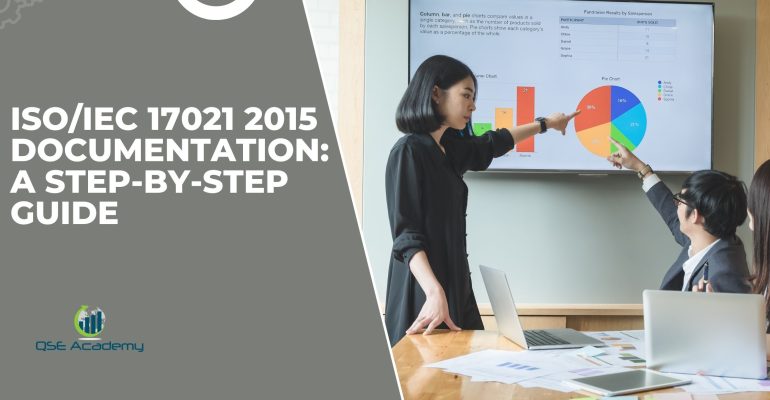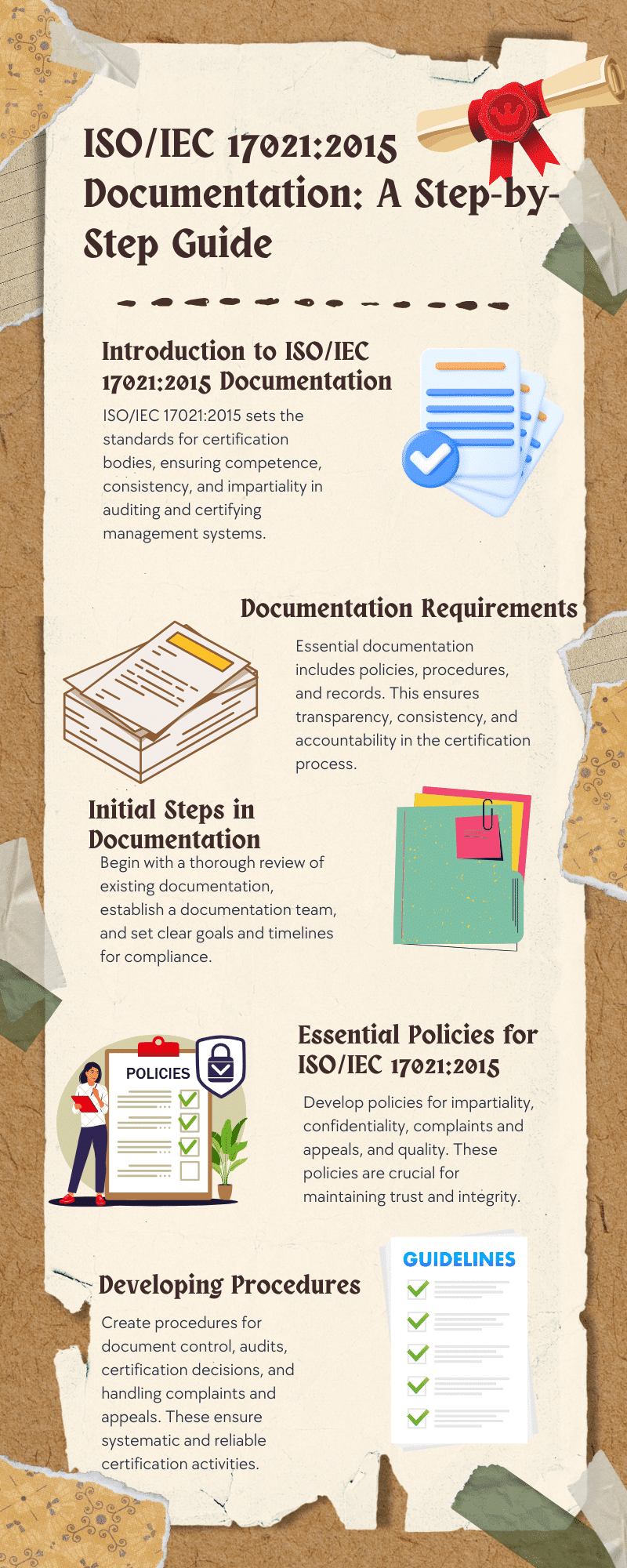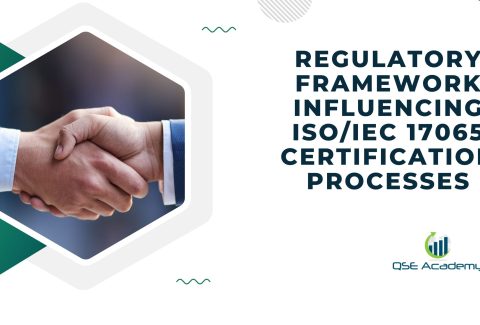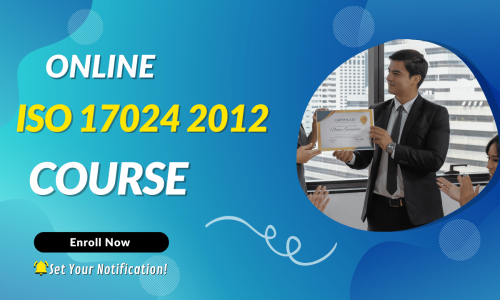ISO/IEC 17021:2015 Documentation: A Step-by-Step Guide
Ensuring the competence of audit and certification bodies worldwide hinges on one critical framework: ISO/IEC 17021:2015. Before an organization can consider itself a trustworthy entity for conducting management system certifications, it must grasp the intricacies of ISO/IEC 17021:2015 documentation. This guiding document not only demonstrates an organization’s commitment to quality and efficiency but also underpins its credibility in an international context. Embark on an insightful journey to decode ISO/IEC 17021:2015 documentation requirements and navigate the path to compliance through a comprehensive step-by-step guide.
As quality management consultants with extensive experience implementing ISO standards, we’ve found that navigating the intricacies of ISO/IEC 17021:2015 documentation can feel overwhelming at first. When we began guiding clients through these requirements, one of the most common challenges we faced was aligning existing management practices with the structured demands of the standard. Through trial, adaptation, and hands-on application across different organizations, we developed a step-by-step approach that not only simplifies the process but also addresses real-world hurdles, like resource limitations and timeline constraints. This guide shares those practical insights, grounded in years of working directly within the field, helping clients achieve compliance without compromising efficiency. By sharing this journey and the lessons learned, we aim to demystify ISO 17021:2015, making it more accessible and actionable for others facing similar challenges.
Introduction to ISO/IEC 17021:2015 Documentation
ISO/IEC 17021:2015 sets the standards for certification bodies that perform audits and certify management systems, ensuring that they operate in a competent, consistent, and impartial manner. This document establishes the criteria for organizations that provide third-party conformity assessment services, ultimately enhancing the integrity of the certification process for various types of management systems.
These types of management systems range from Quality Management Systems (QMS) to Environmental Management Systems (EMS), among others, addressing different fields of quality.
Documentation plays a crucial role in the certification process outlined by ISO/IEC 17021:2015. It ensures that Certification Bodies (CBs) meet the necessary generic requirements for competence, and it upholds the credibility and rigour of the certification decisions made.
In this article, we delve into what ISO/IEC 17021:2015 documentation encompasses, the necessity for Accreditation Bodies and Certification Bodies to maintain such documentation, and the core reasons that substantiate its criticality. Readers will better understand the significance of maintaining comprehensive and compliant documentation, which is essential for the integrity and recognition of the certification issued.
By exploring the fundamental elements, mandatory procedures, and the compliance matrix, readers will learn how proper documentation underpins the reliability and effectiveness of management system certification, thus ensuring value and trust in the resulting quality products and services for both the certified organization and its customers.
Understanding ISO/IEC 17021:2015 Documentation Requirements
ISO/IEC 17021:2015 sets out criteria for organizations providing audit and certification of management systems, ensuring Certification Bodies (CBs) operate competently and consistently. Key to this is comprehensive documentation, which forms the backbone of effective and credible certification processes.
Documentation required under ISO/IEC 17021:2015 encompasses various categories. There are policies, which define the principles guiding the CB’s operations and decision-making. Next, procedures detail the steps for carrying out certification activities, from audits to certification decisions. Records, another documentation type, provide evidence of actual events or actions, underlining accountability and traceability.
Adequate documentation serves multiple functions. It enhances transparency, as stakeholders can understand the basis for certification outcomes. It also ensures that CBs maintain consistency in their certification decisions. This comprehensive documentation infrastructure likewise simplifies the audit and review process, as auditor checklists can directly reference established procedures and records.
To summarize, ISO/IEC 17021:2016 stipulates that CBs maintain the following documentation:
- Policies: Articulating organizational principles.
- Procedures: Outlining steps for certification tasks.
- Records: Recording factual evidence of activities.
Adhering to these documentation demands improves the certification body’s service quality and upholds its technical competence—key aspects scrutinized by Accreditation Bodies. Quality Management Systems thrive when underpinned by precise, accessible, and well-maintained documentation, which is foundational for third-party conformity assessment activity.
Initial Steps in Documentation
When embarking on the path to ISO/IEC 17021:2015 certification, the initial steps in documentation are crucial. Organizations must first conduct a comprehensive Documentation Audit. This process involves a thorough review of all existing documentation to determine its current state against the standard’s requirements. It is essential to identify any discrepancies or inadequacies that need addressing.
Following the audit, a Documentation Team should be established, drawing from various fields of quality within the organization. This team is tasked with the responsibility of spearheading the documentation process. Its members must include key personnel who have a deep understanding of the organization’s management systems, as well as stakeholders responsible for technical competence.
Setting up a Documentation Plan is the next step. This requires the team to outline specific objectives and establish clear goals that align with standard requirements for management systems. The plan should include a realistic timeline that details milestones for the development and implementation of Mandatory Procedures and other necessary documents, such as Standard Operating Procedures, audit checklists, and risk assessments.
Implementing these initial documentation procedures ensures that the organization is well-prepared for the subsequent certification process. It serves to streamline conformity assessment requirements and aids certification bodies in making informed certification decisions. Moreover, this documentation foundation contributes to the organization’s overall objective of providing quality products and services, ultimately maximizing value to customers.
Creating Essential Policies for ISO/IEC 17021:2015
Certification bodies must establish crucial policies to ensure adherence to ISO/IEC 17021:2015 standards, which dictate the requirements for bodies providing audit and certification of management systems. These policies are fundamental to maintain the integrity and professionalism of certification activities.
Impartiality Policy
A cornerstone policy is the Impartiality Policy. Certification bodies must guarantee complete impartiality in their certification operations. This critical element reflects commitment to objective and fair third-party conformity assessment activities. Key elements to consider in an Impartiality Policy include:
- Mechanisms to manage conflicts of interest
- Procedures to ensure objectivity in certification decisions
Confidentiality Policy
Another vital policy pertains to confidentiality. Certification bodies are entrusted with sensitive client information that must be protected rigorously. The Confidentiality Policy should outline:
- Protocols for safeguarding client data
- Employee responsibilities and agreements to prevent unauthorized data sharing
Complaints and Appeals Policy
Transparency and fairness are paramount when dealing with Complaints and Appeals. A robust policy should be established to:
- Offer clear channels for registering complaints or appeals
- Have a defined process for impartial review and resolution
- Ensure timely and appropriate communication to the concerned parties
Quality Policy
Lastly, a comprehensive Quality Policy demonstrates a firm’s pledge to quality in the execution of certification processes. Such a policy focuses on:
- Commitment to meet ISO/IEC 17021:2015 standards
- Strategies for continuous improvement
- Goals for client satisfaction and quality enhancement
Implementing these policies helps certification bodies align with ISO/IEC 17021:2015, fostering trust among stakeholders for the quality and validity of certification outcomes. These policies serve as a foundation for delivering quality products, ensuring technical competence, and upholding a quality management system that resonates with industry best practices.
For compliance and operational efficiency, bodies may incorporate sample formats, standard operating procedures, and audit checklists tailored to their specific needs, alongside these mandates. This holistic approach ensures a robust and quick certification process, offering value and assurance to customers and markets alike.
Developing Procedures
ISO/IEC 17021-2015 sets the bar for organizations that perform certification of management systems, ensuring their services meet global benchmarks for competence and reliability. Central to these requisites is the development of meticulous procedures that govern all certification activities. Four core procedures are paramount in the context of third-party conformity assessment activities:
- Document Control Procedure: This procedure is the backbone of management system certification. It delineates the process for generating, approving, and revising documents. This ensures not only consistency and integrity of the documentation but also its ready availability and accessibility to relevant parties. Proper document control is crucial for maintaining the traceability and credibility of the certification process.
- Audit Procedure: An essential component of certification activities, the audit procedure involves a structured approach to planning and conducting audits. It also covers how audit findings and subsequent actions are to be thoroughly documented. An effective audit procedure is key to the technical competence and transparency of the certification body.
- Certification Decision Procedure: ISO/IEC 17021-2015 prescribes a protocol for making and documenting certification decisions. This procedure is vital in guaranteeing that such decisions are based on evidence obtained according to the standard’s requirements and that impartiality and expertise are consistently applied.
- Complaints and Appeals Procedure: Certification bodies must have a robust mechanism for receiving, reviewing, and resolving complaints and appeals. This procedure must be fair, transparent, and adequately documented to foster trust among stakeholders and allow for continuous improvement of certification practices.
Each of these procedures must be developed with precision to meet the conformity assessment requirements. Collectively, they serve as a compass for certification bodies, guiding their operations and ensuring that the certification process is carried out in a manner that is both systematic and reflective of the highest standards of quality.
| Core Procedure | Objective | Importance |
| Document Control Procedure | Manage document creation, revisions, and approvals; maintain consistency and access | Ensures traceability and credibility of certification |
| Audit Procedure | Plan and execute audits; document findings and actions | Ensures competence and transparency in evaluations |
| Certification Decision Procedure | Make and record certification decisions; maintain impartiality and expertise | Guarantees decisions are evidence-based and fair |
| Complaints and Appeals Procedure | Address complaints and appeals; document and communicate outcomes | Enhances trust and allows for quality improvement in certification services |
Through the meticulous development of such procedures, ISO/IEC 17021-2015 aims to standardize the management system certification process, ensuring that certification bodies operate with the highest level of technical competence and integrity.
Record Keeping and Management
Record keeping and management constitute a crucial aspect of ISO/IEC 17021:2015, which sets forth requirements for bodies providing audit and certification of management systems. This section of the standard emphasizes the paramount importance of methodically documenting various types of records, namely audit data, certification details, personnel competence documentation, and records related to complaints and appeals.
Types of Records
- Audit Records: These encapsulate all relevant documentation accrued during audits, such as evidence collected, reports made, and non-conformity logs.
- Certification Records: These include all material pertinent to the certification process, like application forms, assessment reports, certification decisions, and the certification document itself.
- Training and Competence Records: Documented evidence of qualifications, skills, training, and evaluations of personnel involved in the certification process must be maintained.
- Complaints and Appeals Records: It’s crucial to retain all documentation handling complaints and the appeals process to ensure transparency and fairness.
Record Control Procedures
To guarantee the integrity of records, stringent control measures must be in place:
- Ensuring all records are accurately maintained and fully completed.
- Safeguarding records against unauthorized access or alteration.
- Determining suitable retention periods and secure methods for record disposal.
Retention and Disposal
Each category of records must be retained for a defined time period, typically determined by contractual or regulatory requirements. Once the retention period has lapsed, the standard mandates secure disposal methods to prevent any confidential information from being compromised.
In practice, a tabular format can effectively outline the retention periods for the various types of records, as follows:
| Record Type | Minimum Retention Period |
| Audit Records | X years |
| Certification Records | X years |
| Training and Competence | X years |
| Complaints and Appeals | X years |
Effective record keeping and management are vital for maintaining the credibility of certification bodies and the trust of stakeholders in the validity of ISO certification. It enables these organizations to demonstrate technical competence and adherence to generic requirements in the field of quality, reinforcing the accuracy and reliability of their certification decisions.
Implementing the Management System Documentation
Implementing management system documentation in adherence to ISO/IEC 17021:2015 standards is a strategic process critical for Certification Bodies. To ensure a robust foundation, organizing documents and records is paramount. The documentation hierarchy typically begins with the highest level documents, such as the quality manual, and cascades to lower-level documents, like SOPs, audit checklists, and sample formats.
Communication within the organization is key. Clearly communicating the documentation requirements to staff promotes consistency and prevents mismanagement. It’s vital that all personnel understand their roles within the documentation framework to maintain the technical competence required by the standard.
Here’s an example of a documentation hierarchy:
- Quality Manual
- Mandatory Procedures
- Standard Operating Procedures (SOPs)
- Audit Checklists
- Sample Formats
- Records and Reports
Training and awareness programs are an essential part of the implementation process. Through regular training sessions, employees become adept at managing documentation aligned with ISO/IEC 17021:2015 requirements. Ongoing awareness initiatives help reinforce the importance of these practices, ensuring everyone is up-to-date with the latest procedures and requirements. This proactive approach contributes to the efficiency and quality of third-party conformity assessment activities, ultimately supporting the making of informed certification decisions.
Monitoring and Reviewing Documentation
ISO/IEC 17021-2015 is a crucial standard for Certification Bodies that engage in the certification of management systems. Monitoring and reviewing documentation forms an essential part of maintaining technical competence and ensuring the integrity of certification activities. According to this standard, there are concrete steps that Certification Bodies need to undertake to uphold the quality of their documentation and meet the conformity assessment requirements.
Internal Audits: Certification Bodies must carry out regular internal audits to ensure their documentation aligns with the standard requirements. These audits serve as a tool to measure compliance and identify areas for improvement. During the audit, any documented non-conformities must be addressed promptly to mitigate their impact on the certification process.
Management Reviews: The top management of Certification Bodies should conduct periodic reviews of the documentation. Such reviews are pivotal in steering the strategic direction of the certification activities and in fostering continual improvement of the systems.
Feedback Mechanisms: Implementing robust feedback mechanisms is another integral component of the documentation review process. Feedback from employees and stakeholders can provide invaluable insights into the effectiveness of documentation and highlight potential areas for improvement.
Consistent monitoring and reviewing of documentation not only contribute to the overall quality of the certification process but also reassure customers that the Certification Body operates with the highest standards. These activities reflect a commitment to excellence and transparency in third-party conformity assessment activities, and they are central to maintaining the trust of the market in certified quality management systems.
Continual Improvement of Documentation
Continual improvement is a core aspect of maintaining ISO/IEC 17021:2015 documentation, which aligns with the standard’s requirements for certification bodies performing third-party conformity assessments. Improvement strategies involve setting clear objectives aimed at enhancing the documentation process, such as increasing accessibility or reducing errors. It is vital to consistently monitor and measure how the documentation supports the certification activities, ensuring it contributes positively to the auditing process, risk assessment, and certification decisions. This could involve tracking metrics such as the time taken to locate information or the frequency of document updates.
Implementing appropriate changes is the next step, which may include revising Standard Operating Procedures, audit checklists, or the compliance matrix. These changes should not be executed in isolation but should be updated in the relevant documentation and records to reflect the most current practices. Ensuring that these revisions are effectively communicated to all stakeholders is paramount for smooth operation and adherence to technical competence requirements.
ISO 17021:2015 insists on effective communication strategies to ensure changes in documentation are understood and enacted by certification bodies. Consequently, certification documents, mandatory procedures, and management systems are kept at their peak efficiency, which can lead to quicker certification processes and potentially greater customer satisfaction. It’s a continuous cycle of evaluating performance, applying improvements, and monitoring outcomes that support the certification of management systems and validate the technical competence and quality products of organizations worldwide.
Conclusion
In the arena of management system certification, effective documentation underpins the entire process, echoing its pertinence for certification bodies seeking accreditation to ISO/IEC 17021:2015. As these bodies engage in critical third-party conformity assessment activities, the documentation serves not just as evidence of their technical competence, but as the backbone of their operational integrity. Adhering to stringent documentation requirements, inclusive of Mandatory Procedures, audit checklists, and risk assessments, ensures that the certification process is not only consistent but also upholds the high level of quality necessary for certification decisions.
The benefits of robust documentation practices are multifold—they heighten compliance, reinforce credibility, and expedite the certification process, ultimately saving time and resources. Moreover, such practices assist certification bodies in aligning with the generic requirements specified in the standard, thereby ensuring that their certification of management systems is performed with the utmost diligence.
Organizations striving for a ‘quick certification’ must recognize that the value lies in the journey towards achieving quality principles. Investing effort in comprehensive documentation contributes significantly to this journey. It is a fundamental aspect that continues to play a pivotal role in maintaining and improving quality management systems. Embracing the gravity of proper documentation, organizations can surge ahead, instilling confidence in their clients and stakeholders, ultimately leading to the delivery of quality products and services.
Looking for More Resources on ISO 17021?
If you found this article helpful, explore our premium resources designed to help you achieve ISO 17021 certification efficiently:
- Complete Documentation Package for ISO/IEC 17021-1 2015: Get all the essential templates and documents you need for fast, easy implementation.
- Online Course on ISO/IEC 17021-1 2015 : Enroll in our comprehensive training to master the key concepts and practical steps toward certification.
- ISO/IEC 17021-1 2015 Checklist: Download our detailed checklist to ensure you’ve covered every step of the process.
These resources are tailored to meet your needs and ensure a smooth certification journey. Explore them today and get one step closer to success!



















